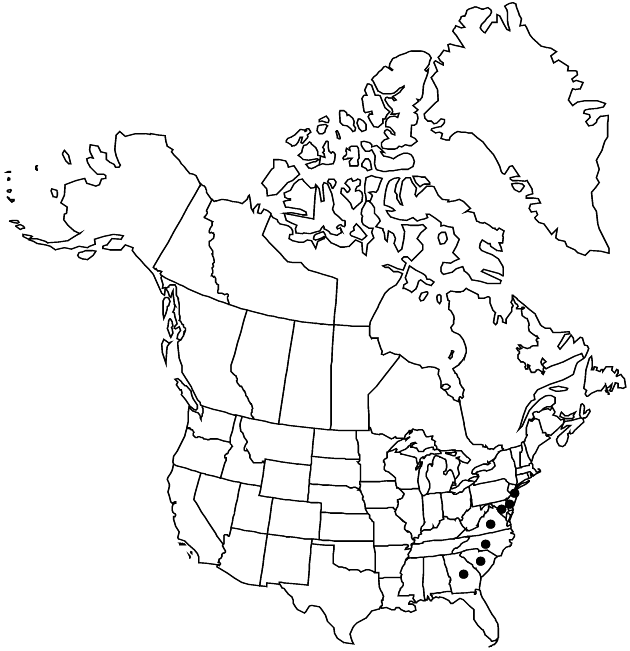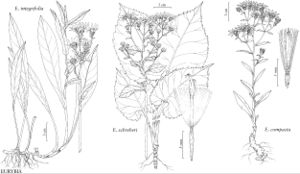Eurybia compacta
Phytologia 77: 259. 1995.
Plants 15–50 (–70) cm, in clumps, eglandular; caudices thickened, woody, ovoid to spheric. Stems 1–8+, erect, simple, strict, glabrescent, usually ± densely villous distally. Leaves basal and cauline, thick, firm (only midnerves conspicuous), margins entire or nearly so, indurate, scabrous, apices indurate, mucronate, faces scabrous (especially distal) to sometimes glabrous, adaxial sometimes villous (especially proximal) at least along midnerves; basal often withering by flowering (bases sometimes marcescent), petioles erect, longer than blades, bases sheathing, winged, ciliate, blades narrowly elliptic to ovate or obovate, 20–70 × 8–20 mm, bases cuneate, margins sometimes crenulate-serrulate, teeth mucronate, apices obtuse to rounded; cauline usually sessile, sometimes subsessile (ascending), lanceolate to oblanceolate, 15–80 (–90) × 2.5–12 mm, bases sheathing to auriculate-clasping (distal), apices acute. Heads 3–55+ in flat-topped, corymbiform arrays, branches ascending, slender. Peduncles slender, villous; bracts 1–2, often 1 near heads, leaflike (bases sometimes indurate and white as in phyllaries). Involucres cylindro-campanulate, 6.5–9 mm, slightly shorter than pappi. Phyllaries 24–35 in 4–5 series, oblong (outer) to lanceolate (inner), unequal, coriaceous (outer) to membranous (inner), bases indurate, rounded (outer), margins hyaline, narrowly scarious, ± erose, ciliate (outer), apices reflexed, green (except innermost), purple-margined, less scarious, rounded or obtuse (outer) to acuminate (inner), mucronate, abaxial faces glabrous or obscurely puberulent, eglandular. Ray-florets (5–) 8–14; corollas blue-violet to rose-purple or bluish, often pale, 5–8 (–10) × 1–1.8 mm. Disc-florets 10–20; corollas pale-yellow, 5.5–6.2 mm, not ampliate, tubes longer than narrowly funnelform throats, lobes triangular, 0.65–0.9 mm. Cypselae stramineous, cylindro-obconic, 1.75–2.6 mm, ribs 9–12 (crowded), faces glabrate to strigillose; pappi of tawny to cinnamon bristles 5.9–6.2 mm, equaling disc corollas. 2n = 18.
Phenology: Flowering midsummer–early fall.
Habitat: Dry, sandy places, dry to moist pinelands, oak-thickets, bogs, barrens
Elevation: 0–200 m
Distribution

Del., Ga., Md., N.J., N.C., S.C., Va.
Discussion
Eurybia compacta may be extirpated from much of its original range (Georgia, Maryland, South Carolina, Virginia) and may now be of conservation concern. It is present on the Atlantic coastal plains and outer Piedmont. A. Cronquist (1980) stated that it approaches E. surculosa on one hand, and E. avita and E. paludosa on the other. This reflects the close affinity between sections Calliastrum and Heleastrum (see above). I have seen no voucher for the Alabama report.
Selected References
None.
Lower Taxa
"[" is not declared as a valid unit of measurement for this property."]" is not declared as a valid unit of measurement for this property."thick" is not a number.
